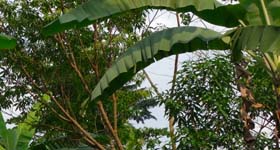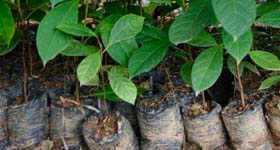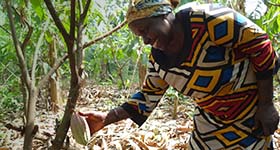Preserving The Environment
Locally, our initiatives have been focused on investing in and utilizing renewable sources of energy, mapping and reducing our carbon footprint, reducing waste to landfill, water saving efforts and transitioning to more responsible material choices and less resource-intensive processes.
We’ve joined forces with other industry members to address cocoa-related deforestation and ensure the protection and restoration of forests for a thriving cocoa community. Providing cocoa farmers with resilience to climate change is important to the long-term sustainability of the cocoa sector. Our participation in the Cocoa & Forests Initiative represents our commitment to forest conservation and the promotion of climate smart agricultural practices like crop diversification, agroforestry, composting, and soil health.

Farm Diversification
Farmers plant local timber species along with other trees and plants such as papaya, cassava, and plantains to not only provide shade and climate resilience for young cocoa trees but to also diversify and increase family incomes long-term.

Women-run, community shade tree nurseries provide additional household revenue and support climate change resilience.

We train farming partners on agroforestry systems, reforestation, forest preservation and protection of local water resources.
Solar Panels: While driving energy conservation, Guittard installed 1 Megawatt of solar panels at our Fairfield facility, reducing our carbon footprint by 1,217MT, equivalent to 206 homes or removing 263 cars from the road. This amount of annual carbon emissions would require 20,120 forest seedlings grown for 10 years, or 1,589 acres of US forests.
EV Fleet: We are proud to partner with Peninsula Clean Energy for the electrical needs of our Burlingame facility. PCE’s EcoPlus program comes from 50% Renewable energy and is 95% greenhouse gas free. We are currently working with PCE to establish EV charging stations for employees and company electric vehicles.

Post-Consumer Recyclable Content: As part of our ongoing efforts to transition to sustainable packaging, we have shifted our flexible film to 24% post-consumer recycled (PCR) materials. This material allows for us to maintain product integrity and shelf life while also minimizing our environmental footprint. The PCR solution reduces our material consumption and lowers our CO2 footprint across the board.
Corrugate Sourced from Certified Paper Sources: Our cardboard packaging is Sustainable Forest Initiative (SFI) certified and our corrugated cardboard, also SFI certified, utilizes 50% recycled content.





